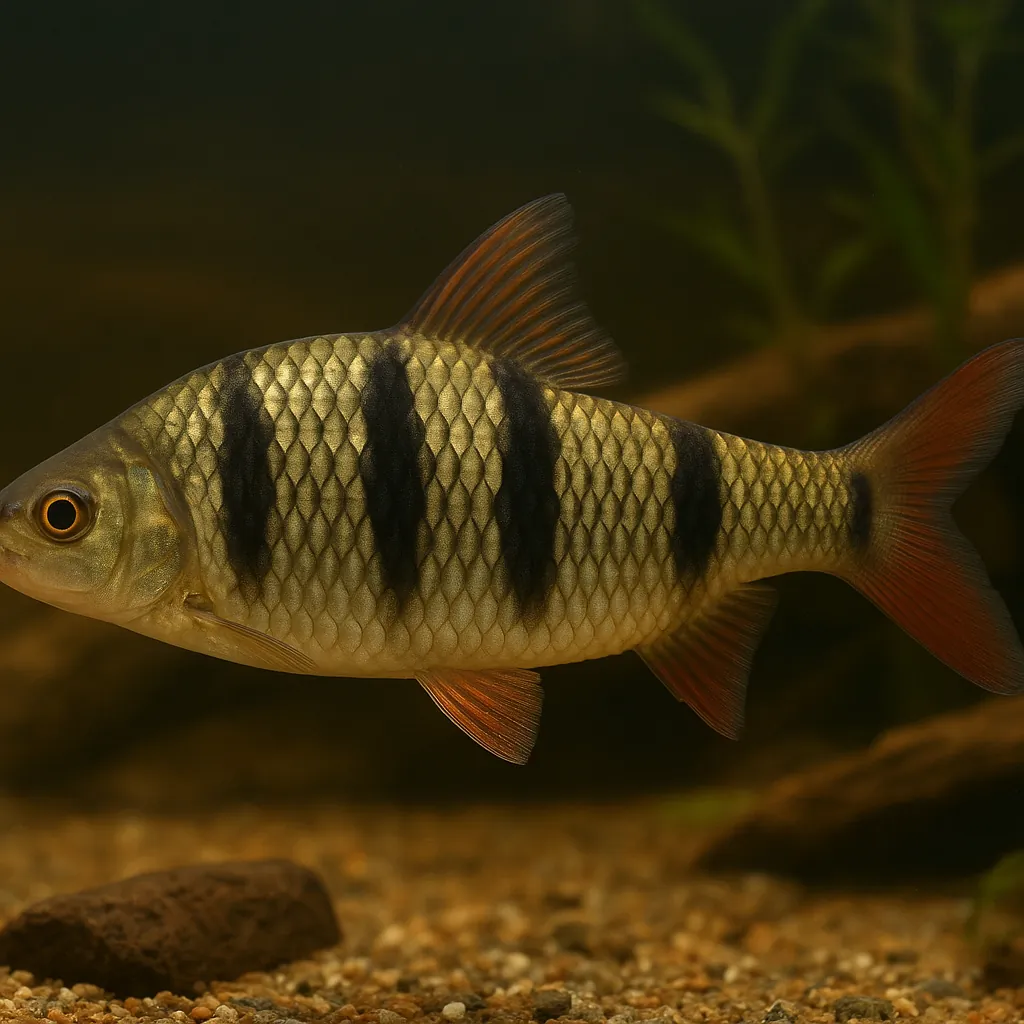
Sixbar distichodus
Introduction
The Sixbar Distichodus (Distichodus sexfasciatus), also known as the Six-banded Distichodus, is a striking freshwater fish native to Africa. Its vibrant orange and black vertical stripes and bright red fins make it a captivating addition to large aquariums. However, due to its substantial adult size and specific care requirements, it is best suited for experienced aquarists prepared to meet its needs.
What makes the Sixbar Distichodus appealing to aquarists?
Its vivid coloration and active swimming behavior add dynamic visual interest to spacious aquariums.
Is the Sixbar Distichodus suitable for beginner fishkeepers?
Due to its large size and specific care requirements, it is more appropriate for intermediate to advanced aquarists.
Care and Environment
Proper care for the Sixbar Distichodus involves attention to tank size, water parameters, diet, and tank setup.
What is the minimum tank size for a Sixbar Distichodus?
A minimum of 540 liters (approximately 150 gallons) is recommended for a single adult specimen. Larger tanks are necessary for groups or community setups.
What are the ideal water parameters for this species?
Maintain a temperature between 22–26°C (72–79°F), pH levels of 6.0–7.5, and water hardness of 10–20 dGH.
What type of filtration and lighting does the tank require?
Strong filtration is essential to handle the waste produced by this large fish, and moderate lighting is sufficient.
What should be included in the tank setup?
Use a sand or fine gravel substrate, and decorate with smooth rocks and driftwood. Hardy plants like Anubias or Bolbitis can be added, as the Sixbar Distichodus may consume softer vegetation.
What does the Sixbar Distichodus eat?
It is omnivorous, accepting high-quality pellets, flakes, and live or frozen foods such as earthworms, prawns, and mussels. Including vegetable matter like blanched spinach and peas is beneficial.
Are there any specific challenges in keeping this fish?
They are known to be excellent jumpers, so a tightly fitting lid is necessary. Additionally, they require high water quality and regular maintenance to thrive.
Origin and Habitat
The Sixbar Distichodus is native to parts of Africa, including Cameroon, the Democratic Republic of Congo, Tanzania, and Lake Tanganyika.
What type of natural habitats does this species inhabit?
It frequents large rivers and lakes with slightly acidic water and temperatures around 25°C (77°F), preferring calm areas or regions with very moderate currents.
How does understanding its natural habitat help in aquarium care?
Replicating similar conditions in the aquarium, such as calm waters and appropriate temperature, helps ensure the fish's well-being.
Temperament and Compatibility
The Sixbar Distichodus exhibits variable behavior in aquariums.
Is the Sixbar Distichodus peaceful or aggressive?
While generally peaceful, some individuals can become aggressive, especially as they mature.
Does this species prefer to be kept alone or in groups?
Juveniles may shoal together, but adults often become increasingly aggressive towards each other, making solitary keeping more advisable.
What are suitable tank mates for the Sixbar Distichodus?
Compatible tank mates include similarly sized, robust species such as large characins, cyprinids, catfish, and bichirs. Avoid housing them with smaller or shy species.
Interesting Facts
The Sixbar Distichodus has several intriguing aspects:
How does the appearance of the Sixbar Distichodus change as it matures?
Juveniles display vibrant orange and black stripes with bright red fins, but these colors often fade as they grow.
Is this species commonly bred in captivity?
Breeding in captivity is rare, and there are no well-documented cases of successful reproduction in home aquariums.
What should potential owners consider before acquiring a Sixbar Distichodus?
Due to its large size and specific care requirements, it's essential to ensure you have the appropriate tank size and experience to provide proper care throughout its lifespan.
Sources
All information in this article has been gathered from the following reputable sources:
Overview
Recommended Tank Size 142.7 Gallons (for a single adult specimen; larger tanks are necessary for groups or community setups) |
Minimum Group Size 1 |
Minimum Tank Volume 142.7 Gallons |
Maximum Adult Length 29.5 inches |
Average Adult Length 15.7 inches |
Shoaling (6+ required) No |
Preferred Water Type Freshwater, slightly acidic to neutral |
Temperature Range (°C) 22–26 |
pH Range 6.0–7.5 |
Water Hardness (dGH) 10–20 |
Typical Lifespan (years) 9 years |